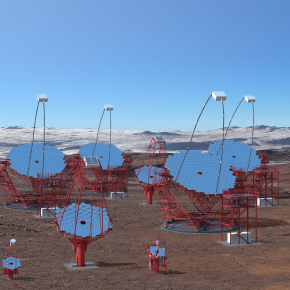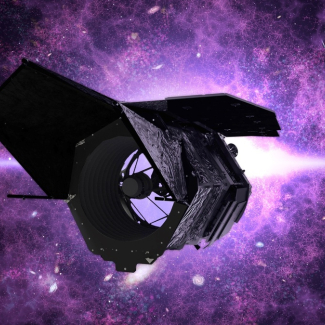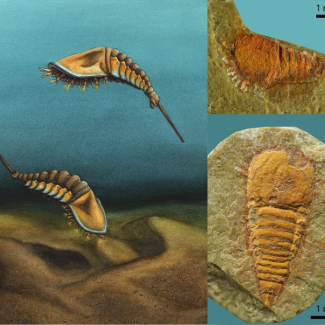
Gamma-ray astrophysics: the Southern CTA Observatory will be installed in Chile
The Cherenkov Telescope Array (CTA) Observatory today announced the signing of three agreements for the construction of its southern site in Chile, specifically on ESO-owned land 11 km southeast of the Very Large Telescope (VLT) in the Atacama Desert. CTA will consist of an array of 118 telescopes located in two sites, one in the Northern Hemisphere and the other in the Southern Hemisphere. CNRS and CEA teams took part in selecting the Southern Hemisphere site and are preparing the instruments for the telescopes. CTA’s first gamma-ray observations of the Universe are expected in 2022.
Gamma-ray astronomy studies the most violent phenomena in the Universe, such as the explosion of massive stars at the end of their lives (supernovae), the activity of galactic black holes, merging black holes and gamma-ray bursts. Combining this with observation at infrared, visible and X-ray wavelengths should enable us to better understand how these incredibly violent cosmic sources act as naturally occurring particle accelerators. Physicists also hope to solve the mystery of dark matter by observing the gamma-ray emissions thought to be produced when it is annihilated.
Cherenkov telescopes, such as H.E.S.S. in Namibia, MAGIC in the Canary Islands and VERITAS in the United States, detect the bluish light visible from the Earth’s surface produced by the interaction of very high energy gamma rays with the atmosphere. To cover the entire sky, it will be necessary to install two telescope arrays of this kind, one in the Northern Hemisphere and the other in the Southern Hemisphere. A total of around a hundred telescopes, specifically constructed for CTA, will study cataclysmic events in the Universe and will be ten times more sensitive than existing instruments.
Contributions from France
Scientists from the CNRS and CEA, in collaboration with their partners, have developed the NectarCAM camera for the 25 Medium-Sized Telescopes (12 metres in diameter). Comprising 1855 highly sensitive photomultipliers, it will record high-energy gamma-ray events (from 100 GeV to 10 TeV) on the nanosecond (10-9 s) scale. A prototype detector is being assembled, and will be tested in Berlin in the first half of 2019 for on-site installation in late 2020.
CNRS laboratories are also working on two other types of telescope. For the four Large-Sized Telescopes (23 metres in diameter) dedicated to low energies (from 20 to 150 GeV), the CNRS designed the upper mechanical structure as well as the mechatronics and computer system for control and monitoring. A Schwarzschild-Couder prototype, a dual-mirror telescope with a wide field of view, has been designed for the 70 Small-Scale Telescopes (4 metres in diameter) dedicated to high energies (> 5 TeV). CNRS teams and their partners also contribute to the observatory's data management components, including the design of the data processing pipeline and tools for scientific analysis of the data. Finally, the CNRS is developing a Raman lidar for atmospheric monitoring.
The CEA has designed very inexpensive, high-performance hexagonal mirror components that will ‘tile’ the 12-metre mirrors of the Medium-Sized Telescopes.

© L. Godart/CEA

French laboratories involved in the CTA:
- l’Institut de recherche sur les lois fondamentales de l’Univers (CEA-Irfu)
- le Centre de physique des particules de Marseille (CNRS/AMU)
- l'Institut de physique nucléaire d'Orsay (CNRS/Université Paris-Sud)
- le laboratoire « Astroparticule et Cosmologie » (CNRS/CEA/Université Paris Diderot/Observatoire de Paris)
- le Laboratoire d'Annecy de physique des particules (CNRS/Université de Savoie Mont-Blanc)
- le Laboratoire Leprince-Ringuet (CNRS/École Polytechnique)
- le Laboratoire physique nucléaire et hautes énergies (CNRS/Sorbonne Université/Université Paris Diderot)
- le Centre études nucléaires de Bordeaux Gradignan (CNRS/Université de Bordeaux)
- le Laboratoire Univers et particules de Montpellier (CNRS/Université de Montpellier)
- le laboratoire « Galaxies, étoiles, physique, instrumentation » (CNRS/Observatoire de Paris/Université Paris Diderot)
- le Laboratoire Univers et théories (CNRS/Université Paris Diderot/Observatoire de Paris)
- l’Institut de recherche en astrophysique et planétologie (CNRS/UT3 Paul Sabatier)
- l’Institut de planétologie et d'astrophysique de Grenoble (CNRS/Université Grenoble Alpes)
- l’Observatoire de la Côte d’Azur.


